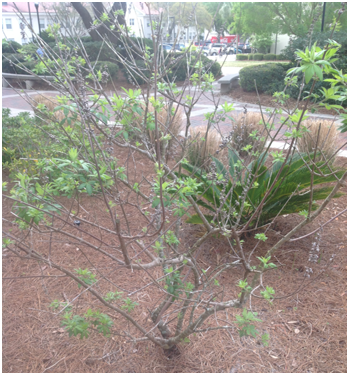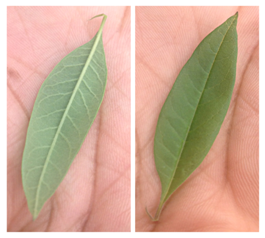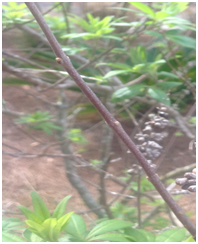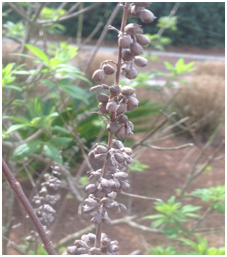Chaste Tree
Vitex agnus-castus

(Photo by Nicole Rutledge)
View the Location on Campus
Taxonomy (1)
Classification: Angiosperm, dicot
Family: Verbenaceae
Common name: Chaste Tree, Chastetree, Monk tree, Hemp tree
General Information (1,2)
Region of Origin: Southern Europe, Western Asia
USDA Plants Hardiness Zones: 6-10
Growth Habit: Shrub or small tree
- Size: 15-20 feet tall
- Deciduous/Evergreen: Deciduous
- Flowering: June-September
Diagnostic Characteristics
Leaves (1)
- Arrangement: Opposite
- Simple/Compound: Compound
- Shape: Lanceolate
- Other: Pubescent

(Leaflet photo by Nicole Rutledge)
Stem/Bark

(Photo by Nicole Rutledge)
Flower (1)
- Color: Lilac to pale violet
- Inflorescence type: Raceme
Fruit (2)
- Fruit type: Dry drupe

(Photo by Nicole Rutledge)
Horticultural Information (2,3)
- Light: Sun to shade
- Moisture: Moderate to moist
- Maintenance: Easy to grow
- Landscape Uses: Specimen tree, mixed with other shrubs
- Other: Drought resistant, best unpruned
Interesting Facts (2)
- Fragrant and attracts pollinating bees and hummingbirds.
- Leaves have medicinal use, and seeds can be used for seasoning.
- The leaves also bear a striking resemblance to those of the marijuana or hemp (Cannabis spp.) plant.
References
1) Dirr, M. (1990). Manual of woody landscape plants: Their identification, ornamental characteristics, culture, propagation and uses (4th ed.). Champaign, Ill.: Stipes Pub..
2) (2004, April 29). Vitex agnus-castus. Floridata. Retrieved March 28, 2013, from http://www.floridata.com/ref/V/vitex_a.cfm
3) Everett, T. H., & New York Botanical Garden. (1980). The New York Botanical Garden illustrated encyclopedia of horticulture. New York: Garland Pub..
Edited by Jessica Bartek
Department of Biology
-
Room 2035, 2nd Floor
Bailey Science Building -
Mailing Address
1500 N. Patterson St.
Valdosta, GA 31698 - Phone: 229.333.5759
- Fax: 229.245.6585
Monday - Thursday
8:00AM until 5:30PM
Friday
8:00AM until 3:00PM
Saturday - Sunday
Office Closed